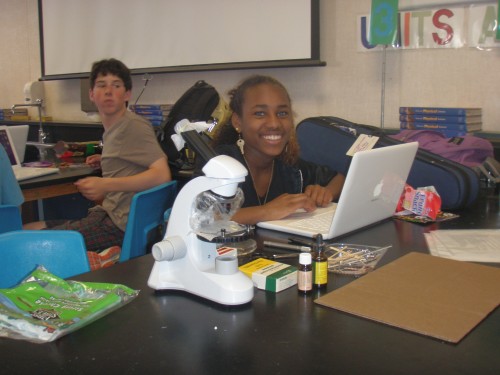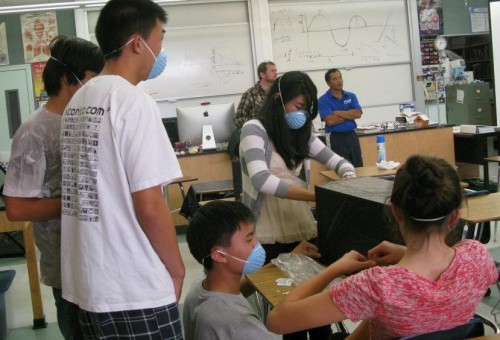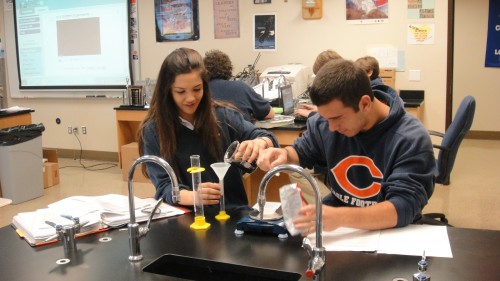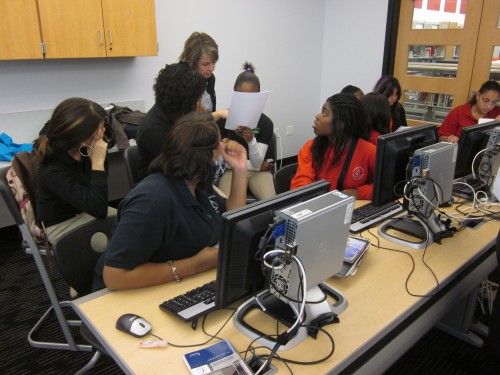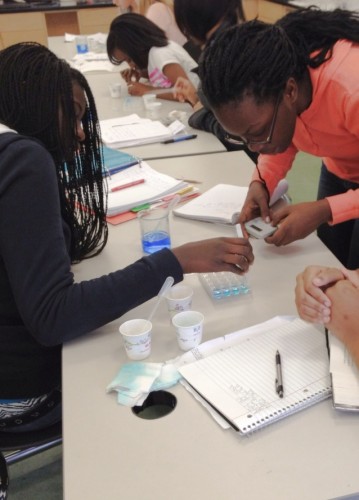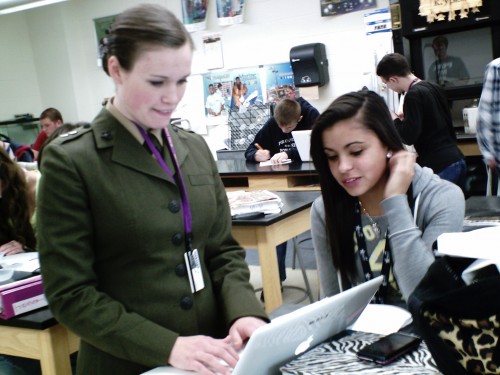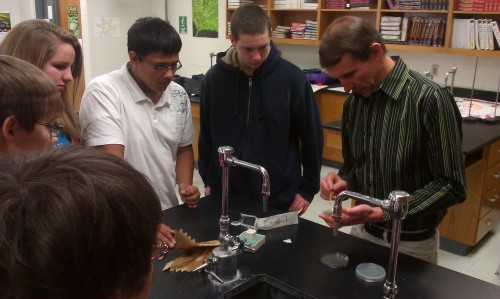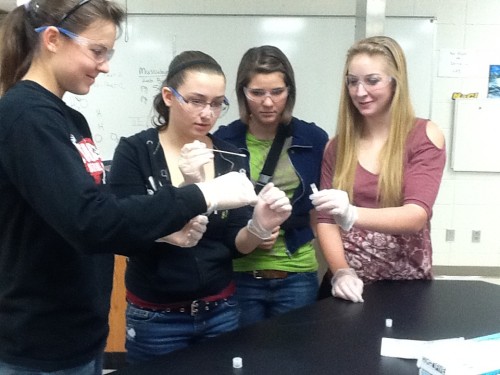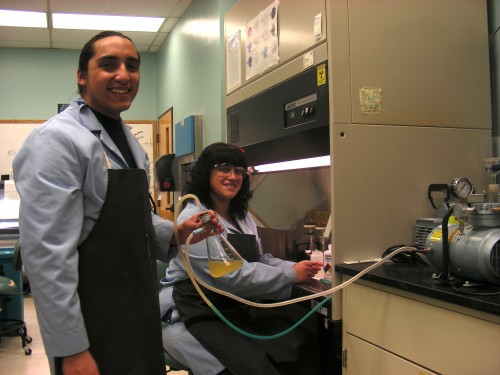Return to ISS Webcast Main page
There are currently 23 very real microgravity experiments aboard the International Space Station (ISS) that were designed, proposed, assembled, and shipped to Johnson Space Center for payload integration by grade 5-14 student research teams across the United States. It is the culmination of nearly 7,000 students fully immersed in every facet of real research as part of Student Spaceflight Experiments Program (SSEP) Missions 1 and 2 to ISS. On this page you are invited to explore the experiments, research teams, and communities taking part in this adventure.
Here’s a thought, is your community ready to be part of the adventure in real science on the high frontier?
NEW FLIGHT OPPORTUNITY: Mission 4 to ISS is now onboarding School Districts
Experiment Design: February to April 2013; flight of selected experiments to ISS: Fall 2013
Read about the opportunity at the SSEP home page: http://ssep.ncesse.org
11 Experiments Comprising the SSEP Mission 2 to ISS Antares Experiments Payload
Jump to Mission 2 to ISS Mission Overview Page
History:
The fourth SSEP flight opportunity—SSEP Mission 2 to the International Space Station—was announced by the National Center for Earth and Space Science Education (NCESSE) on November 16, 2011. As a result, 11 communities across the U.S. joined Mission 2 to ISS, providing 15,120 grade 5-12 students, across 72 schools in 9 States, the opportunity to design and propose real experiments to fly aboard ISS. Student teams submitted 1,125 proposals. Of those, 449 proposals were forwarded for review by Step 1 Review Boards in each of the communities. Each Step 1 Review Board selected three finalist proposals, which were submitted to the National SSEP Step 2 Review Board.
On May 22-24, 2012, the SSEP Step 2 Review Board met at the Smithsonian National Air and Space Museum, reviewed all 33 finalist proposals, and selected one proposal to fly for each community, for a total of 11 flight experiments. The national press release announcing the selection of the Mission 2 to ISS flight experiments is provided in a June 7, 2012, SSEP National Blog post. It is noteworthy that the 1,125 proposals received reflected a total of 3,934 students fully engaged in experiment design.
Current Status:
As of November 8, 2012: the Antares payload of SSEP Mission 2 experiments launched on SpaceX-1 on October 7, 2012, from Cape Canaveral Air Force Station, Florida; berthing of the SpaceX Dragon vehicle with the International Space Station occurred on October 10, 2012, and Antares was transferred to Station; experiment operations began October 11, 2012; ISS Commander Sunita Williams oversees all on-orbit operations for the Antares experiments payload (visit the Experiment Log for a summary of all on-orbit operations to date; on-orbit operations are currently in progress.
1. Santa Monica, California
Jump to Santa Monica’s Community Profile
SELECTED FOR FLIGHT:
What Is the Effect of Microgravity on the Formation of Silly Putty and How Do the Characteristics of That Silly Putty Differ from the Silly Putty Made on Earth?
Grade 8, Lincoln Middle School
Principal Investigator: Cindy Yen
Collaborators: Francis Abastillas, Dean Chien, Matilda Loughmiller, Alex Soohoo, Roman Valentine, and Jane Cho Watts
Teacher Facilitators: Carol Wrabel and Marianna O’Brien, Lincoln Middle School Science Teachers
Jump to Experiment Description and Description of Finalist Proposals
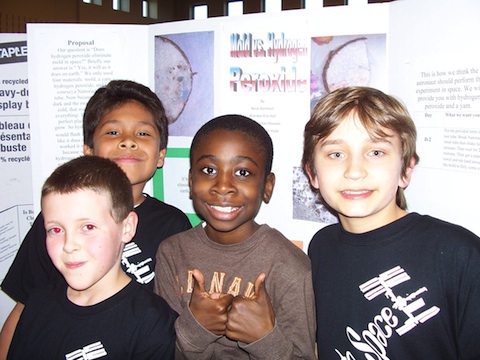
East Lyme, CT: 5th graders Noah, Brandon, Makaih, and Nick are feeling confident after facing the SSEP Step 1 Review Board at East Lyme’s Race to Space Night. Click for Zoom
2. East Lyme, Connecticut
Jump to East Lyme’s Community Profile
SELECTED FOR FLIGHT:
Effectiveness of Hydrogen Peroxide on Aspergillus Niger Growth in Microgravity
Grade 5, East Lyme Middle School
Co-Principal Investigators: Noah Barnhart and Makaih Olawale
Co-Investigator: Nick Hyde
Collaborator: Brandon Hall
Teacher Facilitator: Glenn PenkoffLidbeck, Science Teacher
Jump to Experiment Description and Description of Finalist Proposals
3. Chicago, Illinois
Jump to Chicago’s Community Profile
SELECTED FOR FLIGHT:
Shmooing Around in Space
Grade 6, Mark T. Skinner
Co-Principal Investigators: Jeff Guo and Joshua Tabuena
Co-Investigators: Eric Chen, Stone Chen, Edward Huang
Teacher Facilitator: Kori Milroy, Science Teacher
Jump to Experiment Description and Description of Finalist Proposals
4. Cicero, Illinois
Jump to Cicero’s Community Profile
SELECTED FOR FLIGHT:
Charlotte Goes to Space
Grade 7, Unity Jr. High School
Principal Investigator: Gisela Munoz
Co- Investigators: Aileen Lopez, Daniela Ortega, and Stephany Juarez
Teacher Facilitator: Crystal McDowell, Science Teacher
Jump to Experiment Description and Description of Finalist Proposals
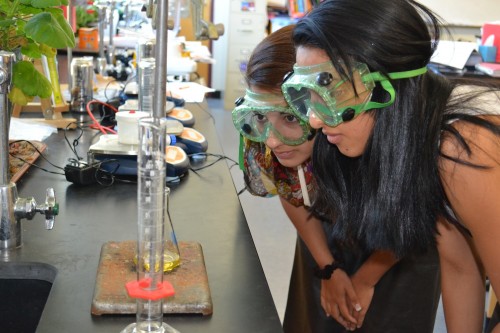
Fitchburg, MA: Nadia and Yeniffer run titrations as they conduct preliminary tests on the experiment. Click for Zoom
5. Fitchburg, Massachusetts
jump to Fitchburg’s Community Profile
SELECTED FOR FLIGHT:
Will Microgravity Have a Significant Affect on Packed Synthetic HBOCs?
Grade 11, Montachusett Regional Vocational Technical School
Co-Principal Investigators: Nadia Machado, Tiffany Nguyen, and Ryan Swift
Collaborator: Yeniffer Araujo
Teacher Facilitator: Paula deDiego, Chemistry Instructor
Jump to Experiment Description and Description of Finalist Proposals
6. Pennsauken, New Jersey
Jump to Pennsauken’s Community Profile
SELECTED FOR FLIGHT:
The Effects of Uric Acid on Bone Deterioration Within a Microgravity
Environment Compared with That on Earth
Grade 9 and 11, Pennsauken High School
Co-Principal Investigators: Michelle Wan and Lacy Smith
Collaborators:
Teacher Facilitator: P. Woodcock, Co-coordinator
Jump to Experiment Description and Description of Finalist Proposals
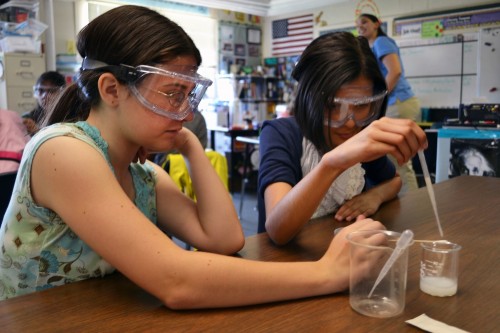
Guilford County, NC: Sixth-graders Evelyn Adriance (left) and Zeynab Warrich, students at Johnson Street Global Studies in High Point, N.C., prepare a swab with solution for their team’s experiment studying the growth of mold in microgravity. Click for Zoom
7. Guilford County, North Carolina
Jump to Guilford County’s Community Profile
SELECTED FOR FLIGHT:
Mold Reproduction Rate in Microgravity
Grade 6-8, Johnson Street Global Studies
Co-Principal Investigators: Evelyn Adriance, Ryan Darden, Jonathan Mickey, and Zeynab Warraich
Co-Investigators: Aya Abdelaziz, Jamie Baxter, Tavin Felton, Ashka Shah, and Summer Shoemake
Collaborators: Mary Dumena, Yodit Getahun, Jamarria Haywood, Mookho Htee, and Ashley Sowell
Teacher Facilitator: Alison Manka, 7th-8th Grade Teacher
Jump to Experiment Description and Description of Finalist Proposals
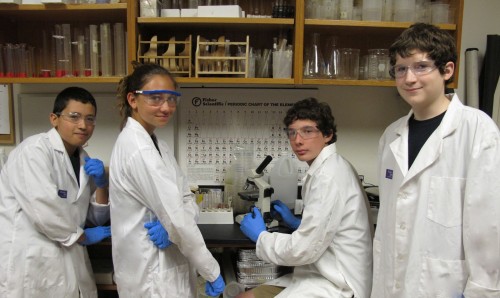
Houston, TX: L to R – Ivan Arizpe, Allie Burns, Austin Abbott, and John Davidson from Pershing Middle School, Houston, TX, work on their project, One Small Step for Bacteria, One Giant Leap for Mankind. Click for Zoom
8. Houston, Texas
Jump to Houston’s Community Profile
SELECTED FOR FLIGHT:
One Small Step for Bacteria, One Giant Leap for Mankind
Grade 8, Pershing Middle School
Co-Principal Investigators: Austin Abbott, Ivan Arizpe, Alexandria Burns, and John Davidson
Teacher Facilitator: Susan Broz, Teacher
Jump to Experiment Description and Description of Finalist Proposals
9. Presidio, Texas
Jump to Presidio’s Community Profile
SELECTED FOR FLIGHT:
The Effect of Microgravity on the Growth and pH of Lactobacilli Acidophilus
Grade 12, Presidio High School
Co-Principal Investigators: Alvaro Ali Romero and Illiana Fernandez
Collaborator: Rafael Sanchez
Teacher Facilitator: Melody Crowder, Science Teacher
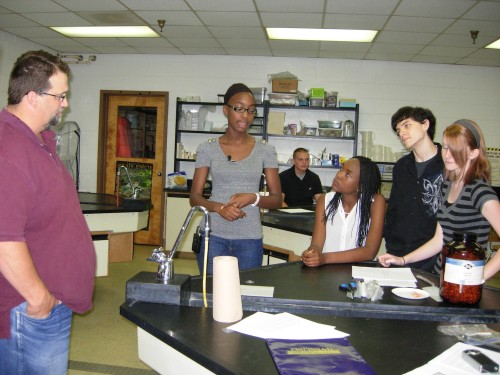
Russell County, VA: Diana Odhiambo explains her team’s experiment on the rate of oxidation of copper and iron in a microgravity environment. Click for Zoom
Jump to Experiment Description and Description of Finalist Proposals
10. Russell County, Virginia
Jump to Russell County’s Community Profile
SELECTED FOR FLIGHT:
The Rate of Oxidation in a Microgravity Environment
Grades 10-11, Lebanon High School
Co-Principal Investigators: Diana Odhiambo, Donna Odhiambo, Jacob Akers,
and McKenna Collins
Teacher Facilitator: Jane H. Carter, Chemistry Teacher
Jump to Experiment Description and Description of Finalist Proposals
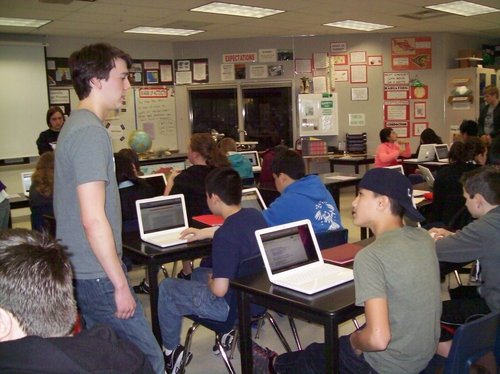
Shoreline, WA: Students from Einstein Middle School in the Shoreline School District work collaboratively on their proposals. Click for Zoom
11. Shoreline, Washington
Jump to Shoreline’s Community Profile
SELECTED FOR FLIGHT:
Crystal Growth with Impurities in Microgravity
Grade 6, Highland Terrace Elementary School
Co-Principal Investigators: Aden Helland, Matthew McMillan, Tuguldur Myagmarsuren, Jack Parkinson, and Dylan Probizanski
Teacher Facilitator: Peggy Nordwall, 6th Grade Teacher
Jump to Experiment Description and Description of Finalist Proposals
12 Experiments Comprising the SSEP Mission 1 to ISS Aquarius II Experiments Payload
Jump to Mission 1 to ISS Mission Overview Page
History:
The third SSEP flight opportunity—SSEP Mission 1 to the International Space Station—was announced by the National Center for Earth and Space Science Education (NCESSE) on July 31, 2011. As a result, 12 communities across the U.S. joined Mission 1 to ISS, providing 41,200 grade 5-14 students, across 92 schools in 9 States and the District of Columbia, the opportunity to design and propose real experiments to fly aboard ISS. Student teams submitted 779 proposals. Of those, 382 proposals were forwarded for review by Step 1 Review Boards in each of the communities. Each Step 1 Review Board selected up to three finalist proposals, which were submitted to the National SSEP Step 2 Review Board.
On December 13-14, 2011, the SSEP Step 2 Review Board met at the Smithsonian National Air and Space Museum, reviewed all 35 finalist proposals, and selected one proposal to fly for each community, for a total of 12 flight experiments. The national press release announcing the selection of the Mission 1 to ISS flight experiments is provided in a January 5, 2012, SSEP National Blog post. It is noteworthy that the 1,125 proposals received reflected a total of 3,490 students fully engaged in experiment design.
THE REST OF THE STORY: The National Center for Earth and Space Science Education was notified after the flight experiment selection that refrigeration would no longer be available on the Soyuz ferry flight to ISS. All flight teams were required to rapidly assess the impact on their flight experiments. Three experiments were potentially impacted. Specific finalist teams that were not selected for flight were asked to step to the plate, and assess loss of refrigeration on their experiments. This allowed 3 back-up experiments to be added to the flight manifest for a total of 15 experiments comprising the Mission 1 Aquarius payload. Then, in preparation for launch, the Soyuz vehicle failed a critical pressurization test and NASA transitioned the Aquarius payload to the SpaceX Falcon 9/Dragon launched May 22, 2012. This flight was a proof-of-concept for the vehicle, and it became the first commercial vehicle to dock with the International Space Station. All student researcher teams recognized they were part of history, heralding in a new era of commercial spaceflight. The SSEP payload was the only research payload on Dragon, and the media coverage was significant.
THE REST REST OF THE STORY: Upon return to Earth of the Aquarius payload, it was quickly determined that none of the Mission 1 experiments were activated in orbit. An inquiry concluded it was a deficiency in the NanoRacks’ astronaut training program on SSEP mini-laboratory operation. The training protocols were corrected, and the experiments were re-flown as the Aquarius II payload, launching with the Mission 2 Antares payload on the first operational flight of the Dragon as SpaceX-1.
This is real spaceflight. This is real research. The obstacles that needed to be overcome provided powerful teachable moments for student researchers across the nation. And when there are obstacles to exploration, you find ways to work around them. You are invited to read the stories of the Mission 1 to ISS adventure—
SSEP Mission 1 Student Researchers to be Part of History: Aquarius Experiments Payload Officially on SpaceX Dragon to ISS, February 13, 2012
SSEP – Real Spaceflight, Real Science: A Remarkable Look Back at Mission 1 Flight Experiment Selection, February 20, 2012
Re-flight of Entire SSEP Mission 1 Payload of Experiments – as Aquarius II – on Upcoming SpaceX Dragon Launch, August 8, 2012
Current Status:
As of November 8, 2012: the Aquarius II payload of SSEP Mission 1 experiments launched on SpaceX-1 on October 7, 2012, from Cape Canaveral Air Force Station, Florida; berthing of the SpaceX Dragon vehicle with the International Space Station occurred on October 10, 2012, and Aquarius II was transferred to Station; experiment operations began October 11, 2012; ISS Commander Sunita Williams oversees all on-orbit operations for the Aquarius II experiments payload (visit the Experiment Log for a summary of all on-orbit operations to date; on-orbit operations are currently in progress.
1. San Marino, California
Jump to San Marino’s Community Profile
SELECTED FOR FLIGHT:
Effect of Microgravity on the Antibacterial Resistance
of P. aeruginosa
Grade 10; San Marino High School
Principal Investigator: Martin Liu
Co-Investigators: Kristie Liu, Ryan Puri, and William Tam
Teacher Facilitator: Joseph Kealoha Carmona, Biological Sciences
Jump to Experiment Description and Description of Finalist Proposals
2. West Hills, California
Jump to West Hill’s Community Profile
SELECTED FOR FLIGHT:
Microgravity Wine
Grades 9 and 10; Chaminade College Preparatory
Co-Principal Investigators: Max Holden and Paige D’ Andrea
Teacher Facilitator: Nancy McIntyre, Program Director
Jump to Experiment Description and Description of Finalist Proposals
3. Hartford, Connecticut
Jump to Hartford’s Community Profile
SELECTED FOR FLIGHT:
How Does Parathyroid Hormone Affect Changes in Bone Mass in Microgravity?
Grades 8 and 12; Annie Fisher Stem Magnet and University High School of Science and Engineering
Co-Principal Investigators: Nick Rapp, Bo-Edward Lawrence, and Samantha Cedeńo
Co-Investigators: Tristan DesRoires, Liam Flannery, and Roshawn Brown
Teacher Facilitators: Dr. Michael Fromerth, Science Teacher, and Keith Sevigny, Biology Teacher
Jump to Experiment Description and Description of Finalist Proposals
4. Washington, DC
Jump to Washington, DC’s Community Profile
SELECTED FOR FLIGHT:
Does Hay Bacillus Break Down Human Waste (Represented by Brown Egg)
in Microgravity as Well as in Earth Gravity?
Grade 8; Stuart-Hobson Middle School
Co-Principal Investigators: Kyra Smith, Daiana James, and JaKayla Smallwood
Teacher Facilitators: Anthonette Peña, Richard Munz, Science Teachers
Jump to Experiment Description and Description of Finalist Proposals
5. Lake County, Indiana
Jump to Lake County’s Community Profile
SELECTED FOR FLIGHT:
Effect of Microgravity on Reproduction of Curli Producing
E. coli O157:H7 438950R
Grade 7; Avicenna Academy
Principal Investigator: Amalia Arceo-Hosken
Collaborators: Ameer Rifai, Jenna Rifai, and Rehan Uribe
Teacher Facilitator: Nicole Gustafson, Teacher
SECOND EXPERIMENT SELECTED FOR FLIGHT:
The Effect of Microgravity on the Quality and Nutritional Value of the Seed
Sprout of a Germinated 92M72 Genetically-Modified Soy Bean
Grades 7 and 8; Highland Christian School
Co-Principal Investigators: Jack Barth and JP Peerbolte
Collaborator: Cameron Zandstra
Teacher Facilitator: Sara Timmer, B.A. Teacher
Jump to Experiment Description and Description of Finalist Proposals
6. Ida County, Iowa
Jump to Ida County’s Community Profile
SELECTED FOR FLIGHT:
Killifish in Space
Grades 9–12; OA-BCIG High School
Principal Investigator: Jessica Gunderson
Co-Investigators: Christian Conover, Josh Dutler, Dane Hannel, Dylan Malcom,
Levi Nunemaker, Lane Prather, Brittanie Rigby, Austin Sadler, Justin Sadler,
and Amy Stangl
Teacher Facilitator: Carol Sadler, Life Science Instructor
Jump to Experiment Description and Description of Finalist Proposals
7. Fitchburg, Massachusetts
Jump to Fitchburg’s Community Profile
SELECTED FOR FLIGHT:
Effect of Arthrobacter on Polyethylene Decomposition Rate in Microgravity
Grades 10 and 12; Montachusett Regional Vocational Technical School
Co-Principal Investigators: Russell Holbert, Victoria Holbert, Brittany Velez, and Miguel Velez III
Teacher Facilitator: Paula deDiego, Science Instructor
Jump to Experiment Description and Description of Finalist Proposals
8. Pleasanton and Norris, Nebraska
Jump to Pleasanton’s and Norris’s Community Profile
SELECTED FOR FLIGHT:
Escherichia coli in Microgravity
Grade 12; Norris High School
Co-Principal Investigators: Amanda Gosselin, Janessa Onwiler, Brianna Petersen, Madison Schoenbeck, and Holly Schurman
Teacher Facilitator: Cindy Larson-Miller, High School Science Teacher
Jump to Experiment Description and Description of Finalist Proposals
9. Houston, Texas
Jump to Houston’s Community Profile
SELECTED FOR FLIGHT:
Hepatocyte Development in Bioscaffolds infused with TGFB3 in Microgravity
Grade 8; Johnston Middle School
Principal Investigator: Emily H. Soice
Teacher Facilitator: Nicole DiLuglio, IPe Teacher
SECOND EXPERIMENT SELECTED FOR FLIGHT:
Will Vitamin C Preserve Bone Density in Microgravity?
Grade 5; Parker Elementary School
Co-Principal Investigators: Maxx Denning, Michael Prince, and Aaron Stuart
Teacher Facilitator: Rebecca Mitchell, 5th Grade Teacher
Jump to Experiment Description and Description of Finalist Proposals
10. El Paso, Texas
Jump to El Paso’s Community Profile
SELECTED FOR FLIGHT:
The Effect of Microgravity on the Use of Cactus Mucilage for Water Purification
College Sophomores; El Paso Community College Valle Verde Campus
Co-Principal Investigators: Naiqui Armendariz and Jesus Castor
Collaborators: Dr. Maria Arteaga, Professor of Chemistry, El Paso Community College, Transmountain Campus; Dr. Bencomo-Álvarez Alfonso Enrique, Laboratory technician of molecular-microbiology diagnostics, Centro de investigación biomédica de occidente, Guadalajara, Jalisco, México; Dr. Norma A. Alcantar, Associate Professor, Dept. of Chemical & Biomedical Engineering, University of South Florida
Teacher Facilitator: Dr. Gertrud Konings-Dudin, Assistant Professor of Biology, El Paso Community College, Transmountain Campus
Jump to Experiment Description and Description of Finalist Proposals



